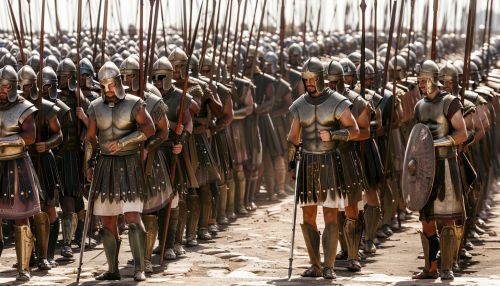Macedonian phalanx
Formation and Equipment
The Macedonian phalanx was a rectangular mass military formation, typically composed of heavy infantry armed with long spears known as sarissas. The soldiers, known as phalangites, were trained to hold their sarissas in such a way that they formed a wall of spears, both in front of them and above them. This formation was used to great effect in the battles of the Macedonian Empire, particularly under the leadership of Philip II and his son, Alexander.


The sarissa was a spear about 4–6 meters (13–20 ft) in length, made of tough and resilient cornel wood. The iron spearhead was leaf-shaped, while the rear end of the sarissa was counterweighted with a bronze butt-spike (sauroter) that could be used as a secondary weapon if the spearhead was broken or lost. The sarissa was held with both hands, one at the balance point, and the other at the end of the butt-spike. The phalangites wore a small shield on their left arm, suspended from the shoulder by a strap, which left both hands free to hold the sarissa.
Tactics and Strategy
The primary tactic of the Macedonian phalanx was the othismos, or the push of shields. The soldiers in the first few rows would thrust their sarissas at the enemy, while those in the rear pushed forward with their shields, creating a literal wall of spears. This tactic was extremely effective in open, flat terrain where the phalanx could maintain its cohesion.
However, the phalanx was vulnerable on rough terrain or when attacked from the flanks or rear. Its strength lay in its frontal assault and its ability to maintain formation. Any disruption in the formation could be disastrous, as seen in the Battle of Cynoscephalae and the Battle of Pydna, where the Roman legions exploited these weaknesses to defeat the Macedonian phalanx.
Evolution and Influence
The Macedonian phalanx evolved from the earlier hoplite phalanx of the city-states of southern Greece. Philip II, who had been a hostage in Thebes and had observed the hoplite phalanx first-hand, adapted and improved upon this formation to create the Macedonian phalanx.
The Macedonian phalanx was the dominant battlefield formation of its time and was used by several Hellenistic kingdoms after the fall of the Macedonian Empire. However, it was gradually replaced by the more flexible Roman manipular formation, which allowed for greater maneuverability on the battlefield.
